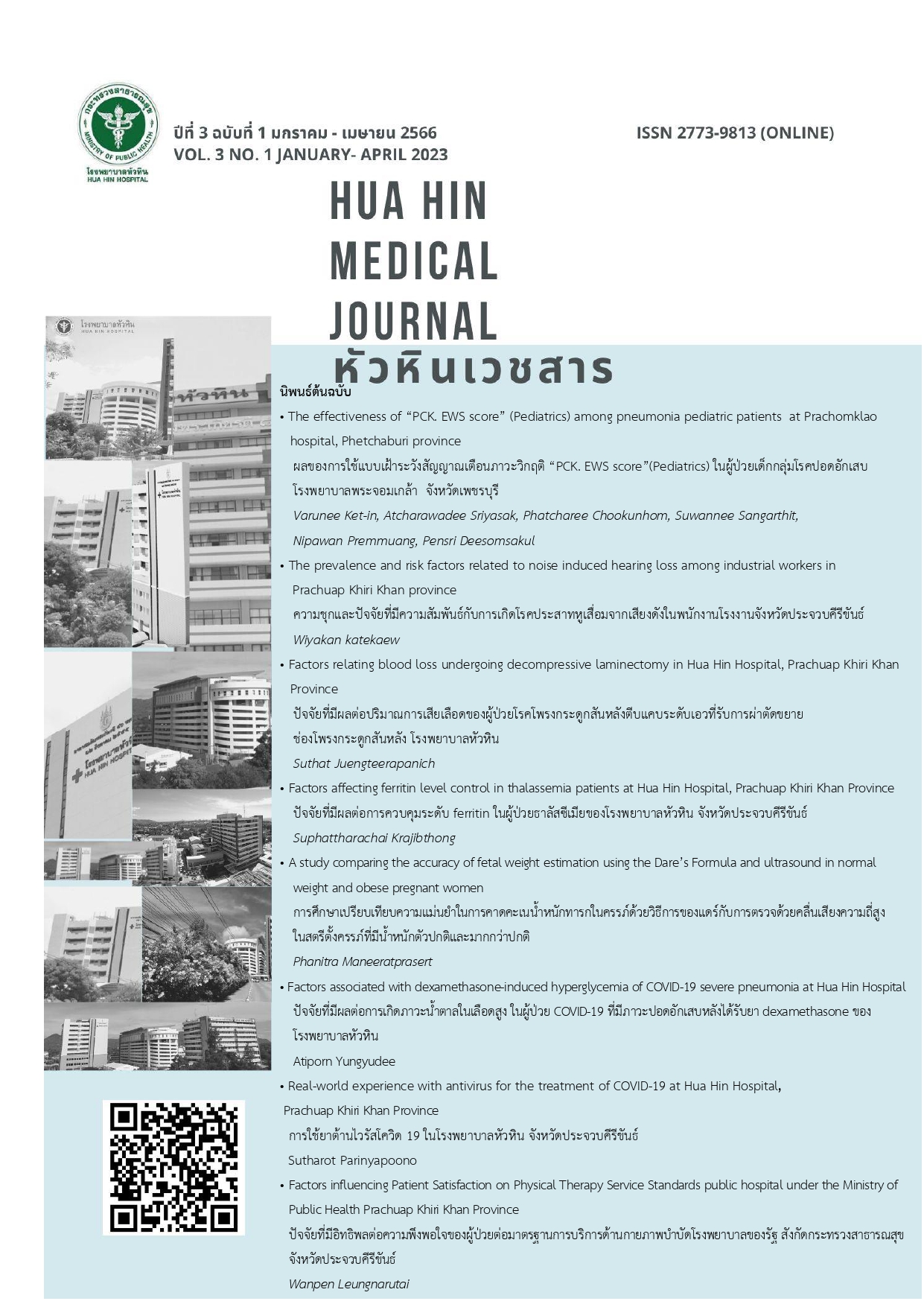A study comparing the accuracy of fetal weight estimation using Dare’s Formula and ultrasound in normal weight and obese pregnant women
Keywords:
Fetal weight estimation, Ultrasound, Dare’s formulaAbstract
Background: Prediction of fetal weight is important to improve the efficiency of birth planning and reduce the incidence of birth injury caused by fetal macrosomia. But nowadays, each method of fetal weight estimation is not very accurate, especially in pregnant women who are overweight and obese, which are more common nowadays.
Objective: To compare the accuracy of Dair's fetal weight estimation with ultrasound in normal and overweight pregnant women.
Materials and Methods: This retrospective study collected data from the medical records of term singleton pregnant women who delivered at Bangbuathong Hospital in Thailand between October 1, 2019, and September 30, 2021. The purpose of the study was to compare the accuracy of fetal weight estimation by ultrasound within five weeks before delivery with the abdominal measurement using Dare’s Formula. They were divided into pregnant women whose BMI before pregnancy was within the normal range (18.5-22.9 kg/m2) and those with BMI over the threshold (> 23kg/m2). The accuracy of fetal weight estimation was determined by the mean of absolute percent error, not more than 10%.
Results: There were 215 pregnant women, 103 were normal weight and 112 were overweight. The mean ages were 26.4+6.3 and 28.4+6.3 (p=.02), respectively. The pregnant women in the high BMI group had a higher incidence of pre-existing medical conditions, and pregnancy complications, and delivered infants with higher birth weights than those in the normal BMI group. The overall accuracy of fetal weight estimation using Dare’s Formula and ultrasonography was significantly different (60% vs 79.5%, p<0.0001). In the normal and high BMI groups, ultrasound was more accurate than clinical estimation using Dare’s Formula (83.5% vs 57.3%, p<0.0001), (75.9% vs 62.5%, p<0.03) respectively.
Conclusions: Ultrasonography was more accurate in predicting fetal birth weight than Dare’s formula in full-term singleton women.
References
Aekplakorn W, Mo-Suwan L. Prevalence of obesity in Thailand. Obesity reviews. 2009 Nov;10(6):589-92.
Jitnarin N, Kosulwat V, Rojroongwasinkul N, Boonpraderm A, Haddock C, Poston W. Prevalence of overweight and obesity in Thai population: Results of the National Thai Food Consumption Survey. Eating and Weight Disorders. 2011;16(4):e242-e9.
Consultation WE. Appropriate body-mass index for Asian populations and its implications for policy and intervention strategies. Lancet (London, England). 2004 Jan 10;363(9403):157-63.
Somprasit C, Tanprasertkul C, Rattanasiri T, Saksiriwuttho P, Wongkum J, Kovavisarach E, et al. High pre-pregnancy body mass index and the risk of poor obstetrics outcomes among Asian women using BMI criteria for Asians by World Health Organization Western Pacific Region (WPRO): a large cohort study. J Med Assoc Thai. 2015;98(Suppl 2):S101-S7.
Begum KS, Sachchithanantham K, Somsubhra SD. Maternal obesity and pregnancy outcome. Clinical and experimental obstetrics & gynecology. 2011;38(1):14-20.
Alwash SM, McIntyre HD, Mamun A.
The association of general obesity, central obesity and visceral body fat with the risk of gestational diabetes mellitus: Evidence from a systematic review and meta-analysis. Obesity Research & Clinical Practice. 2021;15(5):425-30.
He X-J, Dai R-x, Hu C-L. Maternal prepregnancy overweight and obesity and the risk of preeclampsia: A meta-analysis of cohort studies. Obesity research & clinical practice. 2020 Jan-Feb;14(1):27-33.
Cunningham FG, Leveno KJ, Bloom SL, Spong CY, Dashe JS. Williams obstetrics, 26e: Mcgraw-hill New York, NY, USA; 2022.
Menticoglou S. Shoulder dystocia: incidence, mechanisms, and management strategies. International Journal of Women's Health. 2018 Nov 9;10:723-32.
Prajapati DG, Patel RM. Comparison of various method of fetal birth weight estimation in term pregnancy. International Journal of Reproduction, Contraception, Obstetrics, and Gynecology. 2018;7(3):1058-65.
Odekunle JO, Yohanna S, Ariyo BO. Accuracy of the product of the symphysis-fundal height and abdominal girth in prediction of birth weight among term pregnant women at Keffi, Nigeria. African Journal of Primary Health Care and Family Medicine. 2020;12(1):1-6.
Wisarutkasempong A, Chobkhayan S. การศึกษาเปรียบเทียบการคาดคะเนน้ำหนัก ทารกในครรภ์ในระยะคลอดด้วยวิธีการของ Dare และ Johnson และความสัมพันธ์กับ น้ำหนักทารกเมื่อแรกเกิด. Journal of Health Science-วารสารวิชาการ สาธารณสุข. 2020;29(4):637-45.
Aueamnuay S., Chara T. Estimation of Foetal Weight Using Johnson’s Formula and Dare’s Formula. Kuakarun Journal of Nursing. 2020;27(2):155-63.
Lertrat W, Kitiyodom S. Accuracy of intrapartum fetal weight estimation using dare’s formula and transabdominal ultrasonography in pregnant women with normal and high prepregnant BMI at Maharat Nakhon Ratchasima Hospital. Thai Journal of Obstetrics and Gynaecology. 2021:313-21.
Sánchez-Fernández M, Corral ME, Aceituno L, Mazheika M, Mendoza N, Mozas-Moreno J. Observer Influence with Other Variables on the Accuracy of Ultrasound Estimation of Fetal Weight at Term. Medicina. 2021;57(3):216.
Zahran M, Tohma YA, Erkaya S, Evliyaoğlu Ö, Çolak E, Çoşkun B. Analysis of the effectiveness of ultrasound and clinical examination methods in fetal weight estimation for term pregnancies. Turkish Journal of Obstetrics and Gynecology. 2015 Dec;12(4):220-5.
Borisut P, Kovavisarach E. Standard intrauterine growth curve of Thai neonates delivered at Rajavithi hospital. J Med Assoc Thai. 2014;97(8):798-803.
Dhand NK, Khatkar, M. S. Statulator: An online statistical calculator. Sample Size Calculator for Comparing Paired Proportions. 2014 [Available from: https://statulator.com/SampleSize/ss 2PP.html#.
Itarat Y, Buppasiri P, Sophonvivat S. Fetal weight estimation using symphysioundal height and abdominal girth measurements in different pre-pregnancy body mass indices. Thai Journal of Obstetrics and Gynaecology. 2017:167-74.
Okafor CO, Okafor CI, Mbachu II, Obionwu IC, Aronu ME. Correlation of ultrasonographic estimation of fetal weight with actual birth weight as seen in a private specialist hospital in southeast Nigeria. International journal of reproductive medicine. 2019;2019:3693797.
Benacerraf BR, Gelman R, Frigoletto Jr FD. Sonographically estimated fetal weights: accuracy and limitation. American Journal of obstetrics and gynecology. 1988 Nov;159(5):1118-21.
Benson-Cooper S, Tarr GP, Kelly J, Bergin CJ. Accuracy of ultrasound in estimating fetal weight in New Zealand. Australasian Journal of Ultrasound in Medicine. 2021Jan 12;24(1):13-9.
Moraitis AA, Shreeve N, Sovio U, Brocklehurst P, Heazell AE, Thornton JG, et al. Universal third-trimester ultrasonic screening using fetal macrosomia in the prediction of adverse perinatal outcome: A systematic review and meta-analysis of diagnostic test accuracy. PLoS medicine. 2020 Oct;17(10):e1003190.
Downloads
Published
How to Cite
Issue
Section
License
Copyright (c) 2023 Hua-Hin Hospital

This work is licensed under a Creative Commons Attribution-NonCommercial-NoDerivatives 4.0 International License.
บทความที่ได้รับการตีพิมพ์ในวารสารหัวหินเวชสาร เป็นลิขสิทธิ์ของโรงพยาบาลหัวหิน
บทความที่ลงพิมพ์ใน วารสารหัวหินเวชสาร ถือว่าเป็นความเห็นส่วนตัวของผู้เขียนคณะบรรณาธิการไม่จำเป็นต้องเห็นด้วย ผู้เขียนต้องรับผิดชอบต่อบทความของตนเอง







